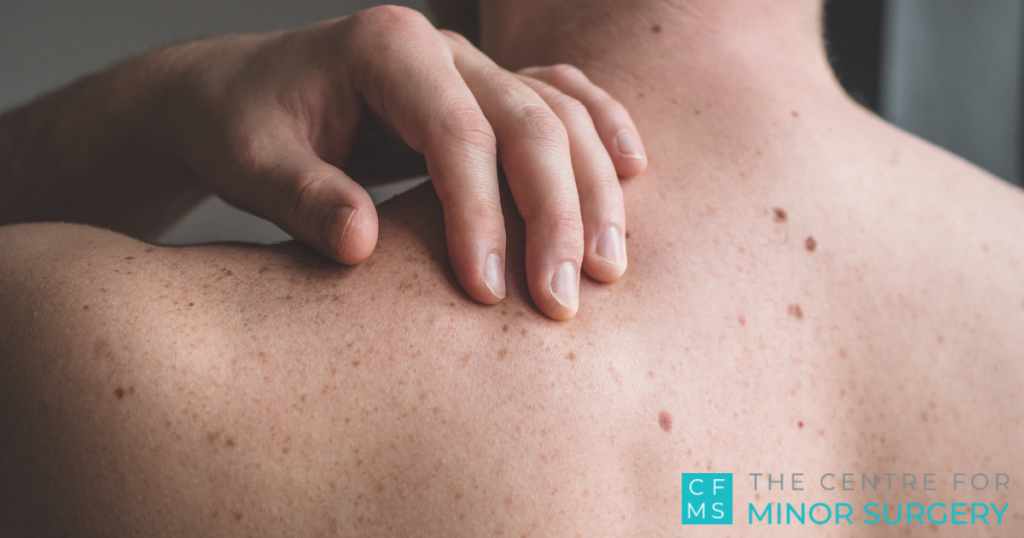Do you have a bump that appeared after you nicked your skin and now won’t go away? If it’s raised, pink or brown, and less than a centimetre in diameter, there’s good news: It’s likely harmless, and you can get rid of it in a snap with dermatofibroma removal at our Toronto clinic.
What are dermatofibromas, and what is it like to have them removed at The Centre for Minor Surgery? Read on to learn more.
1. Dermatofibromas Sometimes Appear After a Minor Skin Injury.
Dermatofibromas are small, firm lumps or nodules on the skin, ranging in colour from pink to dark brown. They most commonly appear on young women’s arms and legs, although men and women of all ages can experience them.
Sometimes, they appear as a reaction to a cut, scrape, prick, or even a bug bite. As your skin works to heal the injury, some cells in the dermal layer overgrow, leaving behind a raised mark on the skin that is often permanent.
2. They Aren’t Dangerous or Cancerous.
If you’ve noticed a dermatofibroma on your skin, you don’t have to worry about rushing to get it treated. These nodules are harmless, noncancerous, and don’t need to be removed for any medical reasons. However, you can choose to have them removed for cosmetic purposes if a certain bump or spot is bothering you.
3. You Can Take a Quick Dermatofibroma Pinch Test.
If you have what you think may be a dermatofibroma but don’t have an official diagnosis, it’s a good idea to have it evaluated to rule out other conditions. Your doctor may do a quick dermatofibroma pinch test by squeezing the bump. Dermatofibromas will appear as a depression when pinched; a mole will protrude from the skin when squeezed. They may also examine the spot using a dermatoscope.
Dermatofibromas don’t usually change in shape or size, and they don’t typically hurt or itch. If your spot is changing or itching, it’s important to have a health care provider examine your skin. When it comes to new growths or spots on your skin, it’s always better to err on the side of caution and have them checked just in case.
4. Surgical Removal Is Often Best.
Some physicians choose to treat dermatofibromas via shave excision, a technique our surgeons often use for mole removal. While this works well temporarily, it carries a risk of the nodule eventually growing back.
With surgical removal, our Royal College-certified plastic surgeons make sure all layers of the affected cells are removed so the area can heal fully. In most cases, this gives you long-lasting results so you only have to treat the area once.
5. Dermatofibroma Removal Cost Is Affordable.
Because removal is not considered medically necessary and is done for cosmetic purposes, OHIP does not usually cover it. At our Toronto clinic, dermatofibroma removal costs $495 and is generally a one-time procedure. When you visit us, you can count on exceptional results delivered by Royal College-certified plastic surgeons, often on the very same day of your consultation.
6. Removal Requires Only Local Anesthesia.
The procedure to remove a dermatofibroma is a quick and minor surgery, so you don’t have to go under general anesthesia.
During the procedure, our surgeons freeze the affected spot to make it easier to remove entirely. This is the only part of the process some people describe as uncomfortable. Once the cold gives way to numbness, you shouldn’t feel any other discomfort as your surgeon removes the nodule and closes your sutures.
7. You’ll Have a Tiny Scar.
Because the surgery involves a small incision, it does leave behind a minimal scar. Our surgeons specialize in meticulous techniques designed to disguise scarring and create as little visible change to the area as possible.
8. Recovery Is Quick & Easy.
You can typically drive home and return to your usual activities right after your procedure. However, it’s best to avoid very strenuous activities that may strain your incision for a week or two until it has fully healed.
If you would like to learn more about your Toronto dermatofibroma removal options, please request a consultation or call us at (416) 663-9649.


Leave a Reply